

Windows Millennium
with Netscape Communicator
Configurations for CVC Internet, LLC
Please Note: These
instructions are for users
who have experience setting up software programs.
If you notice a difference in
setup windows, please take the general
information listed below and apply them in the appropriate windows.
********************************************************************
DO NOT MAKE
ANY OF THESE CHANGES,
WITHOUT YOUR WINDOWS OPERATING SYSTEM CD/DISKS
*******************************************************************
- Step 1 - Dialup Networking -
1.) When you turn on your computer system, Windows will load a main screen (the desktop). On the main desktop, double-click on the My Computer icon.
2.) In the My Computer window, double-click on the Dial-up Networking icon.
3.) In the Dial-Up Networking window, double-click on the Make New Connection icon
(sample window below).

4.) This will bring up a Make New Connection screen that contains two fields.
Insert the following information:

5.) The next screen will list the following fields, enter :

6.) The next screen will indicate, you have successfully created a Dial-up Networking connection called CVC Internet. Down at the bottom of the screen, click on the Finish button (sample screen below).
.
7.) You should now have a CVC Internet icon (two computers with CVC Internet underneath) located in the Dial-up Networking window. Single-click on the CVC Internet icon (to make it highlighted), then go to the top of the Dial-up Networking window, click on the File menu and select Properties. In the Properties window, General screen, check the following screens:
a.) Area Code: should show 541 (make
sure there is no 1 in front of the area code).
b.) Telephone Number: should show your CVC
Internet dial-in phone number.
(make sure there is no 1
in front of the phone number).
c.) Country Code: should show United States
of America (1)
d.) Use Country Code and Area Code: if you
have this option,
make sure there is a check mark
beside this option.
8.) In the Properties window, General screen, click on the Networking tab.

9.) In the Networking screen, Advanced Options section, select only Enable Software Compression (if the other options are selected, click on the box to remove the check mark).
In the next section, Allowed Network Protocols, select only TCP/IP (if the other options are selected, click on the box to remove the check mark).
To continue setup, double-click on the TCP/IP Settings button, or click once on the TCP/IP Settings tab (option for TCP/IP Settings will vary according to the version of Windows you are using, sample screen below).

10.) In the TCP/IP screen, select the following items:
Make sure these options are the ONLY items selected in this screen, then click
OK.
(sample screen below)

11.) Keep clicking on the OK button until you are back to the Dial-up Networking window. Your dialer is now set. For software programs that do not automatically put a CVC Internet dialer icon on the desktop, please refer to step 12, otherwise refer to step 13.
12.) (From step 11) In the Dial-up Networking window, right-click (once) on the CVC Internet icon and select Create Shortcut. This will bring up a screen stating: Windows cannot create a shortcut here. Do you want the shortcut to be placed on the desktop instead? Click Yes. This will place the CVC Internet dialer icon on your desktop. To finish dialer setup, please continue to step 13.
13.) To make sure the Windows Networking is set correctly, follow these steps:
***** DO NOT MAKE ANY OF THESE CHANGES WITHOUT
YOUR WINDOWS OPERATING SYSTEM CD/DISKS! ******
On the desktop, double-click on My Computer. In the My Computer window, double-click on the Control Panel icon. In the Control Panel window, double-click on the Network icon.
In the Network window, Configuration screen, the following items must be installed.
(sample window below)
If the above items are installed, go to step 17.
14.) If Client for Microsoft Networks is not installed, go to
step 19a.
15.) If Dial-Up Adapter is not installed, go to step 20a.
16.) If TCP/IP is not installed, go to step 21a.

17.) Highlight the Dial-Up Adapter, click on Properties, then click on Bindings.
18.) Make sure only TCP/IP is checked, uncheck any other Protocol listed,
then click OK. This will take you back to the Network window, at
the bottom of this window click on the OK button.
Once you are back in the Control Panel window, click on the X at the top right-hand corner of the window (this close the window). And to get back to the desktop, click on the X at the top right-hand corner of the My Computer window.
To finish the dialer setup, refer to Step 22.

19a.) Click on Add, highlight Client then click on Add again
(sample screen below).

19b.) Highlight Microsoft (in the Manufacturers window), then Client for
Microsoft Networks
(in the Network Clients window), and click OK
(sample screen below).
Return to step 17.

20a.) Click on Add, highlight Adapter and click on Add again
(sample screen below).

20b.) Highlight Microsoft (in the Manufacturers window), then
highlight Dial-Up
Adapter (in the Network Adapters window), and click OK
(sample screen below).
Return to step 17.

21a.) Click on Add, highlight Protocol and click on Add again
(sample screen below).

21b.) Highlight Microsoft (in the Manufacturers window), then highlight
TCP/IP
(in the Network Protocols window), and click OK, then return to
step 17.

22.) To test your CVC Internet dialer for correct configurations, double-click on your CVC Internet icon (on your desktop). This will open an Connect To window. In this window, make sure your CVC Internet username is in the username box (@cvc.net should not be listed), then type the password in the password box (if the password is automatically listed, do not enter any information). At the bottom of the Connect To window, click on the Connect button. The next window to appear, will indicate the modem dialing into the server, then verifying the password and username. Once the connection is established, the connection speed and time will appear.
Please Note: you will not be able to access the Internet, until the browser configurations are in place. To continue with the setup, click on the Disconnect button in the connection window, then refer to Browser/Mail configurations listed below.
If you are unable to establish an Internet connection, recheck the dialer settings. Make sure your CVC Internet username and password are in lowercase (@cvc.net should not be listed). Next, make sure the Area Code is 541, and Dial-in Number reflects your CVC Internet Dial-in Number. If all of the information checks fine, and an Internet connection still can't be established, re-boot your computer (close all programs, shut off computer and monitor for at least 5 minutes). Once your system has been refreshed, try re-establishing an Internet connection. If everything fails, check to see if your modem is configured correctly. If the modem is not configured, contact your computer distributor and/or computer repair shop to get your modem fixed. CVC Internet is only responsible for providing Internet access. If your equipment or programs are not working correctly, you will need to contact the appropriate people to fix the problems.
Once your dialer is working correctly, Do Not Change Your Settings! This will only cause you unnecessary problems.
- Step 2 - Browser Configurations -
1.) To begin setup, double-click on Netscape
Communicator's icon (on the desktop).
Do Not connect to the Internet, setup can be done off-line.
2.) When Communicator's browser window opens, click on the Edit
menu
(at the top of the browser's window), and select Preferences.
3.) In the Category window (side menu, left-hand side of the
Preference window),
double-click on Appearance.
4.) In the Appearance window (right-hand side of the Preference window), insert the following:
(Refer to Example C-1)
Example C-1
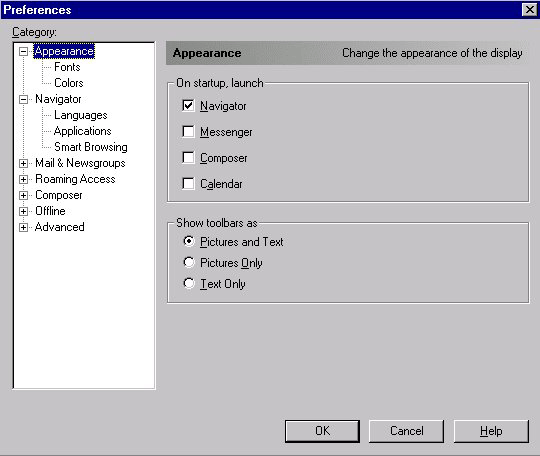
5.) In the Category window (side menu, left-hand side of the
Preference window),
double-click on Navigator.
6.) In the Navigator window (right-hand side of the Preference window), insert the following:
(Refer to Example C-2)
Example C-2

7.) In the Category window (side menu, left-hand side of the Preference window), double-click on Mail & Newsgroups and select Identity. In the Identity window (right-hand side of the Preference window), enter the following:
(Refer to Example C-3)
Example C-3
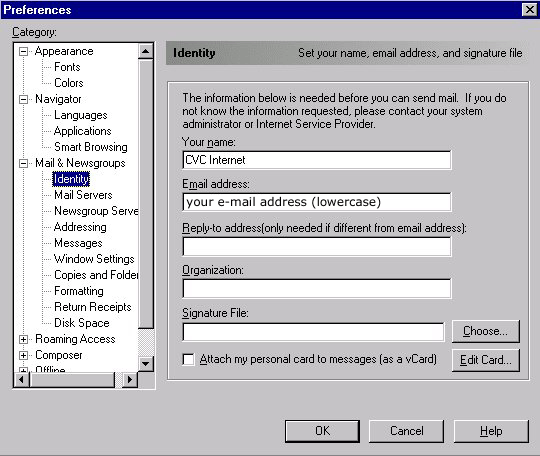
8.) In the Category window (side menu, left-hand side of the Preference window), double-click on Mail & Newsgroups and select Mail Servers.
9.) In the Mail Servers window, enter the following information:
(Refer to Example C-4)
Example C-4
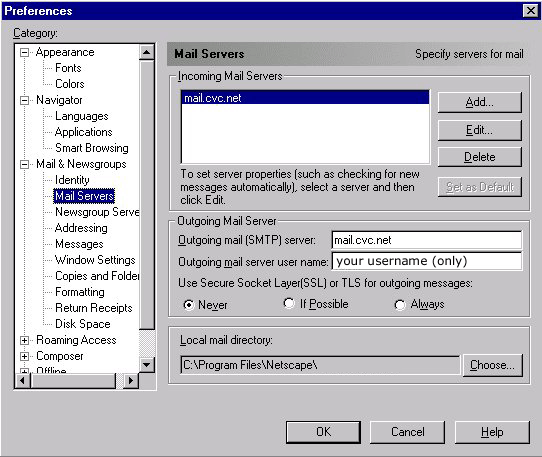
10.) To continue Mail Servers setup, click on the Edit button, beside
the Incoming Mail Servers box
(in the Mail Servers window).
In the Mail Server's Property window, click on the General tab and complete the following steps:
(Refer to Example C-5)
Example C-5
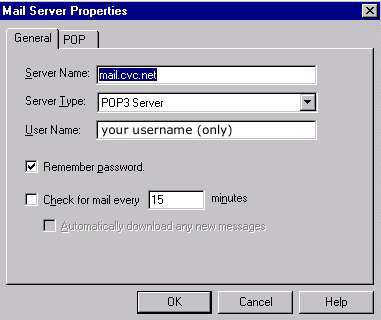
11.) Next, click on the POP tab (in the Mail Server Properties window), and make sure Leave Messages on Server is Not Selected. If box is checked, click on the box to uncheck it.
To save Mail Server settings, click on the OK button at the bottom of the window.
(Refer to Example C-6)
Example C-6
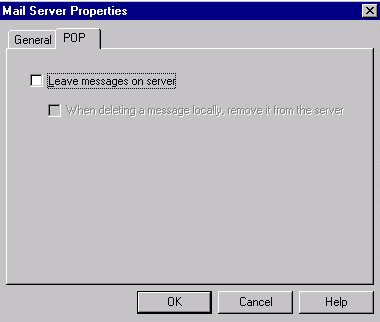
12.) In the Category window (side menu, left-hand side of the Preference window), underneath the Mail & Newsgroups menu, select Newgroup Servers.
13.) In the Newsgroup Servers window, insert the following:
(Refer to Example C-6)
Example C-6

14.) At the bottom of the Preferences window, click on the OK button.
15.) Then at the top of Netscape's browser window, click on the File Menu and select Close (closing Communicator will refresh the program).
Your Finished! For help in making an Internet connection, please refer to CVC Internet's Help Guide, How to Connect to the Internet. To learn how to use Netscape for browsing and e-mail, please refer to the Help menu within the Netscape program.
Please Note: Once your browser and e-mail are working correctly, Do Not Change Your Settings. Changing your settings can cause you problems!
NETSCAPE CACHE - Version 4.01
To keep Netscape Communicator running at it's best, make sure to periodically clean the disk & memory cache. The cache stores graphics of sites you browse on the Internet, so the next time you revisit the site it will load the page much faster. But after extensive browsing the cache will become plugged, causing problems with browsing and e-mail.
To clean the disk & memory cache, follow the steps below.



You are now ready to open Netscape and browse the Internet.
Netscape Navigator &
Communicator
- Software Technical Information -
E-mail:
info@netscape.com
Phone:
1-650-937-2555
Mac Help:
http://help.netscape.com/
<<<<< Back to CVC Internet's Help Guide.
Copyright © 1996-2008, CVC Internet, LLC. All
rights reserved.
Certain names, logos, designs, titles, words or
phrases on this site may
constitute trademarks, service marks or trade names
of CVC Internet, LLC.,
or other entities which may be registered in certain
jurisdictions.
This
web site contains links to other Internet sites, and
such links are not
endorsements of any products or services of such
sites, and no information
in
such Internet sites has been endorsed or approved by
CVC Internet, LLC.
CVC
Internet, LLC disclaims any responsibility, if some
web site you link
to has material on it that offends you in any way.
If problems or
questions arise with the use of any of the linked
web sites, please
contact the company that owns or operates the
Internet site.